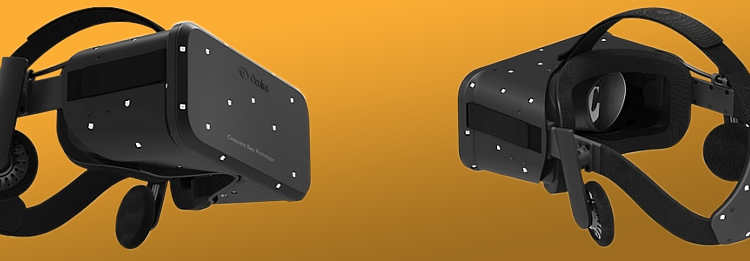The Oculus VR conference that we experienced live last night gave a little more than expected, since Oculus has finally confirmed some details of its Crescent Bay prototype, which indicate the direction in which the development of the first version of the commercial product is progressing.
The conference, which was attended Palmer Lukey, Nate Mitchell, and Ryan Brown of Oculus with Paul Bettner of Playful Corp (creators of Lucky’s Tale) was spent in a tone quite relaxed and friendly, with some moments even fun, like the quick glances between Palmer and Nate when it was confirmed that Crescent Bay gave the jump to two screens, as if both were not very sure if you were doing well, to be washed out. It was without a doubt the high point of the night, and Nate Mitchell stated that the change occurred almost a year ago (remember that Crescent Bay was presented publicly in September), which is not much less of a last minute decision, and gives us to understand that it is the best choice possible with the current technology, since both Valve (or HTC) as Oculus finally have opted for this solution. Perhaps if HTC Vive had not been presented they would have kept the secret longer, but it seems right to us that little by little they are giving some details, in the absence of a release date, which was by the way the first question from the audience (or rather from social networks) that Nate Mitchell threw to Palmer just after the conference started.
Another issue with which Oculus coincides with HTC is in the use of Fresnel lenses, something that Palmer Luckey had publicly ruled out quite some time ago, but as he recognized yesterday, virtual reality today is constantly changing and evolving, and what they took for granted yesterday may change completely today or tomorrow. And this is where the not so good news comes in, since another of the questions was whether Palmer Luckey’s statement that if they had not launched a commercial product by the end of 2015 it would be a symptom that something had gone really wrong was still valid. Here we seemed to notice a small gesture of discomfort in Palmer, who claimed that such a statement was made before some of the latest changes that eventually gave rise to Crescent Bay. To try to take some of the iron out of the matter, Nate Mitchell stated that in any case the CV1 is going to be a really extraordinary product and that we will all understand that the wait will have been worth it. Certainly, we are left with the feeling that the CV1 is not going to appear this year, but we think that the launch announcement should be made, and starting to get wet we would say that they will do it when the pre-purchase date of HTC Vive approaches, which is obviously much more competitive than Morpheus, exclusive for PS4.
And speaking of exclusivity, Palmer Luckey gave good news by confirming that Oculus Rift is not going to be a closed platform associated only with Facebook or the Oculus Store. We will be able to install what we want, from anywhere (directly connected to Steam) and on various operating systems. The truth is that we already had it, but it’s always good to have official confirmation, although we would have liked some explicit mention of an integration into the Steam VR ecosystem. By the way, they congratulated both Sony, HTC and Valve for their great work developing the headsets that Oculus will have to compete with, stating once again that everything that pushes the virtual reality sector will have an impact for the benefit of everyone, Oculus included. Nate Mitchell stated that this does not put any added pressure on them, since the pressure is given to them by themselves and it does not seem that the launch of other competitors, presumably before their own, will influence their plans. However, a comment from Nate Mitchell has caught our attention when he has been asked about the need for rooms dedicated to virtual reality, indicating that Oculus could make an announcement soon related to the requirements of its system, and this can be interpreted in several ways: equipment requirements, room, free space… and it is that, as in the case of the two screens and the Fresnel lenses, Nate affirms that Oculus no longer rules out supporting a standing experience, as has been seen in the Crescent Bay demos.
Regarding the control issue, they did not pronounce on Valve’s Lighthouse system, and Palmer insisted on the difficulties of achieving a good control system, explicitly mentioning finger tracking, something that seems to be an Oculus goal. He stated that it will be impossible to obtain a standard controller for virtual reality, since there will be different types of experiences within it, and a flight simulator with a HOTAS system is not the same as a driving one with a steering wheel, or a small-scale strategy game, in which a wand-type controller seems more indicated. Palmer commented regarding the simulators that they would like us to be able to see our real peripherals, or a digital reproduction of them, in the virtual world, although he has not given to understand that his work was in this direction either.
Finally, Palmer reaffirms that the main objective of Oculus and surely of virtual reality in general during the first years will be video games. For example, Nate confirms that Oculus allocates about 2% of its resources to the Story Studio, a division that they recently introduced to create cinematic experiences. And little more to highlight from this small talk, we are still looking forward to the announcement of the commercial version of Oculus and it does not seem that they intend to do it in the short term. Moreover, there are indications that the launch will not take place this year, but everything remains to be seen today.








